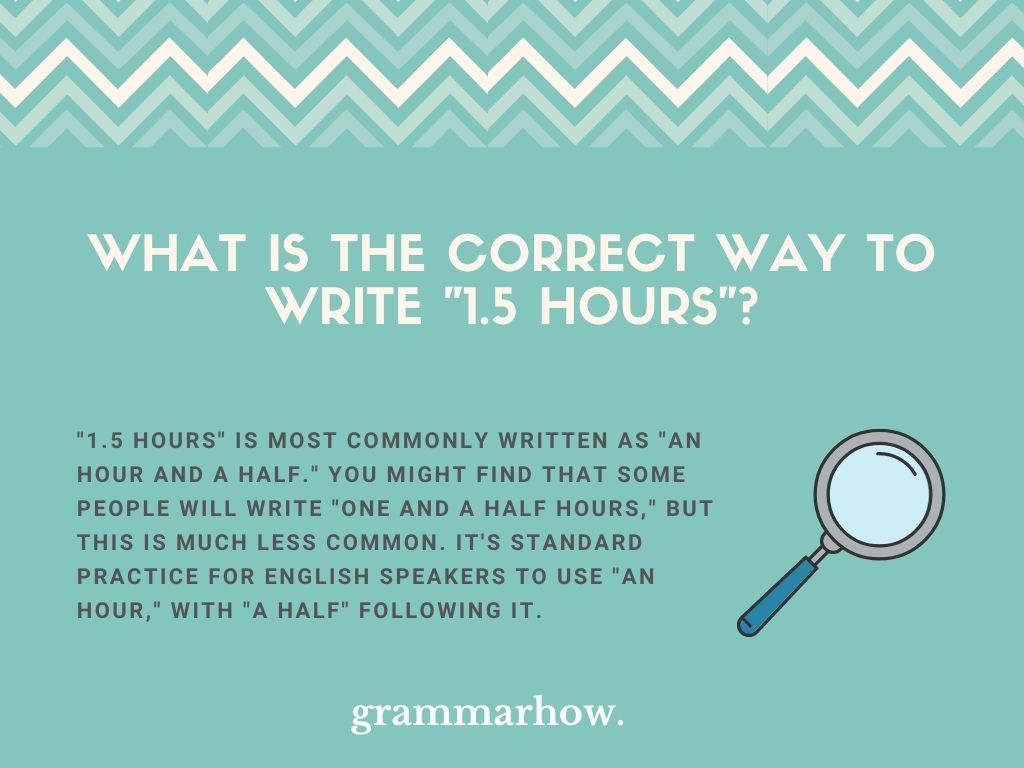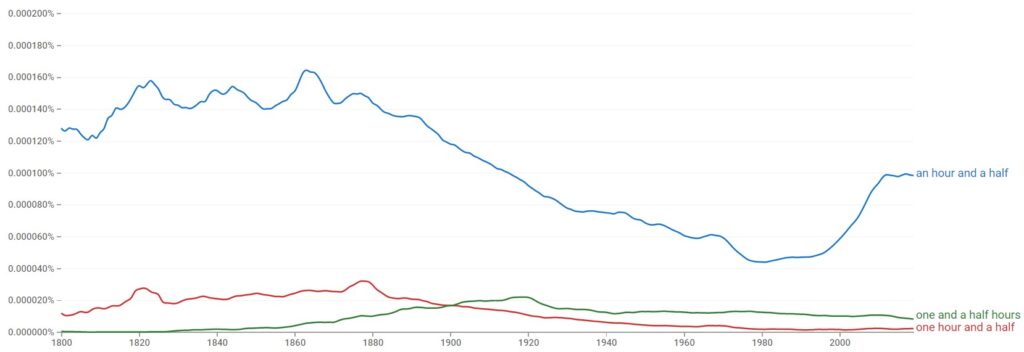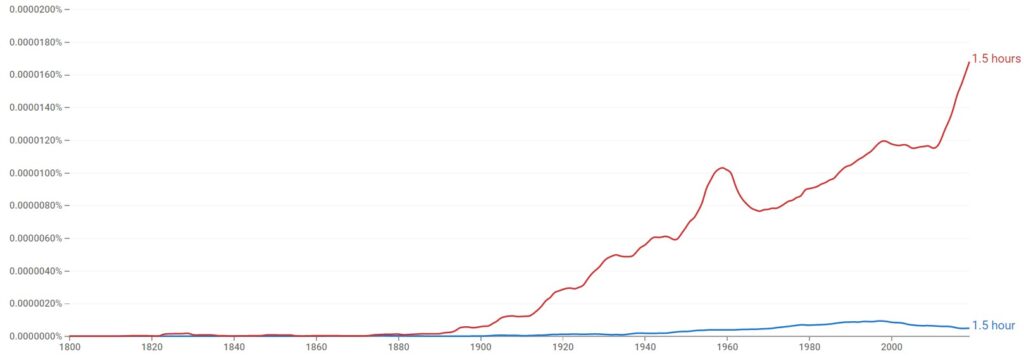When you want to express “1.5 hours” in words (rather than numbers), you might find things a bit confusing. It seems like “one and a half hour” and “an hour and a half” both work, but is one more appropriate? This article will help you understand it.
What Is The Correct Way To Write “1.5 Hours”?
“1.5 hours” is most commonly written as “an hour and a half.” You might find that some people will write “one and a half hours,” but this is much less common. It’s standard practice for English speakers to use “an hour,” with “a half” following it.

However, this rule only applies when we are using 1.5 hours. For most other numbers, it’s more common for the order to be as follows:
- Number + fraction + “hours”
So, the following make sense:
- 2.5: Two and a half hours
- 3.5: Three and a half hours
However, it does not work as often with 1.5 because it’s much more common for native speakers to stick to using “an hour” instead of one hour.
Generally, we can associate common language trends with what English speakers find to be more natural. “An hour and a half” is linguistically easier to pronounce (and write), which means that “one and a half hours” is rejected. It sounds much more jarring.
What Is The Correct Way To Write “1.5 Hours” In Words?
There are still a few different ways to write “1.5 hours.” We’ll go over the true and correct way in a little more detail.
“An hour and a half” is the correct way to write “1.5 hours.” You should always stick to writing it in this form because it is what most native speakers will be used to hearing. Any other variation sounds robotic and jarring, so they are ignored.
We can also refer to Google Ngram Viewer to show you that “an hour and a half” is by far the most popular variation. We’ve included “one hour and a half” and “one and a half hours” as other variations, but the other two are nowhere near as popular.

An Hour and a Half
Sometimes, certain words and phrases are just more popular. There doesn’t always need to be a reason. Some people just tend to prefer the simpler ways to say things.
“An hour and a half” is a good example of this. It’s much simpler than the other two variations, which is why it stuck around as the official form. Many native speakers will use this form and only this form.
In fact, it’s so popular that you’ll be much less likely to hear any other form. Native speakers will think they sound strange, and they might even call you out for mispronunciation or poor grammatical choices.
One Hour and a Half
“One hour and a half” is the least popular. Again, this comes down to native speakers preferring to use “an” instead of “one” when they’re only talking about one hour.
It’s similar to saying “an apple” rather than “one apple” when you’re simply talking about one singular item or thing in front of you.
One and a Half Hours
We mentioned above that the common format for writing out hours is number + fraction + “hours.” However, this is only applicable to numbers other than one (like “2.5 or 3.5 hours”).
“One and a half hours” follows standard rules that other numbers follow, but it is not the one we use. We only ever use “an hour” when we’re trying to be concise about how long it is until something happens.
Is It “1.5 Hour” Or “1.5 Hours”?
It would help to know whether “hour” or “hours” is correct after 1.5 as a number. After all, it doesn’t quite seem to refer to a plural form in itself.
“1.5 hours” is correct. We should always write “hours” as a plural form when dealing with fractional words and numbers. “Hours” is a countable noun, and we use “1.5” as a way to demonstrate when something will happen.
- This will take place in 1.5 hours.
- You have 1.5 hours to get this done.
According to Google Ngram Viewer, “1.5 hours” is by far the most popular choice of the two. This is because it’s the much more common variation, and it’s the one that follows the most grammatical rules.

There is one instance where “1.5 hour” might work, but it’s only when used as a compound adjective:
- This is a 1.5-hour game, I’m afraid.
Here, if “1.5 hour” modifies a noun (“game”), we can use it in the singular form.
What Is “1.5 Hours” In Minutes?
It would help to know what 1.5 hours is in minutes since some people prefer to refer to it in that way.
1.5 hours is ninety minutes. One hour is always sixty minutes long, so it makes sense that half an hour equals thirty minutes. When we add the two values together, we’re left with ninety minutes.
Is It “1.5 Hours” Or “1.3 Hours”?
Some people get a little confused when doing the maths for minutes and hours. After all, sixty minutes is one hundred percent of an hour. Those numbers don’t always align in people’s brains.
Some people think 1.3 hours is correct to refer to one hour and thirty minutes. However, .3 does not refer to thirty minutes. It actually only refers to about twenty minutes. .5 is correct because thirty minutes is exactly half of sixty, meaning it’s the fifty percent mark.
If you’re still confused, you can work out what 1.3 hours are by dividing an hour by three. This will give you an estimate (since 1.33 recurring would be the exact answer). Nevertheless, 1.3 hours is closer to one hour and twenty minutes than it is thirty minutes.
Is It “1.5 Hours” Or “1,5 Hours”?
Most American and British schools teach that decimal places should be created with periods. This means that 1.5 hours is correct. However, other European schools (other than British ones) teach that the comma is more appropriate, making 1,5 hours correct.
Is It Ever Correct To Use “1 1/2 Hours”?
“1 1/2 hours” is correct in writing because we’re still demonstrating what the fraction is. The fraction is included as “1/2,” which can be read as “a half.”
You may also like:
An hour or A hour? Here’s the correct version + FULL explanation
“Half An Hour” vs. “Half Hour”: Which Is More Correct? (Important Facts)

Martin holds a Master’s degree in Finance and International Business. He has six years of experience in professional communication with clients, executives, and colleagues. Furthermore, he has teaching experience from Aarhus University. Martin has been featured as an expert in communication and teaching on Forbes and Shopify. Read more about Martin here.
